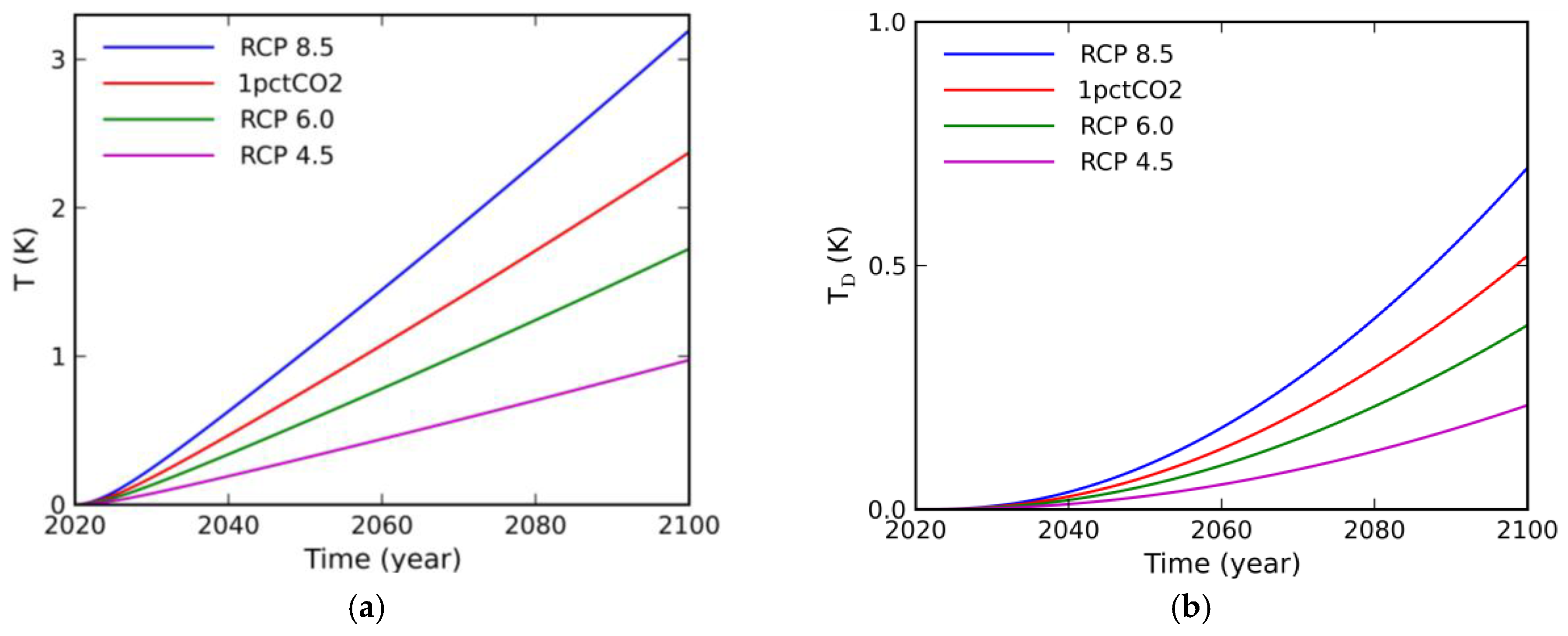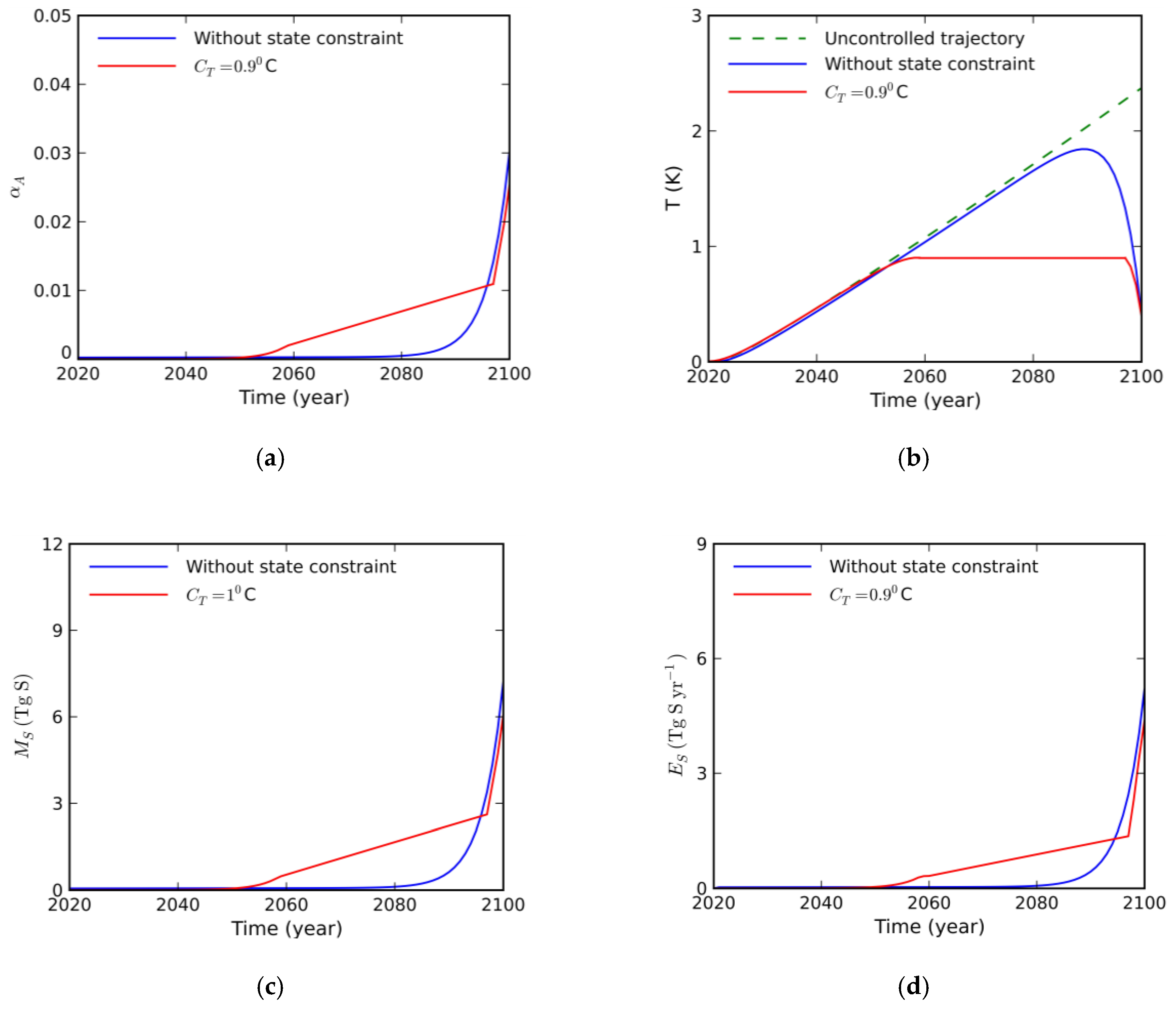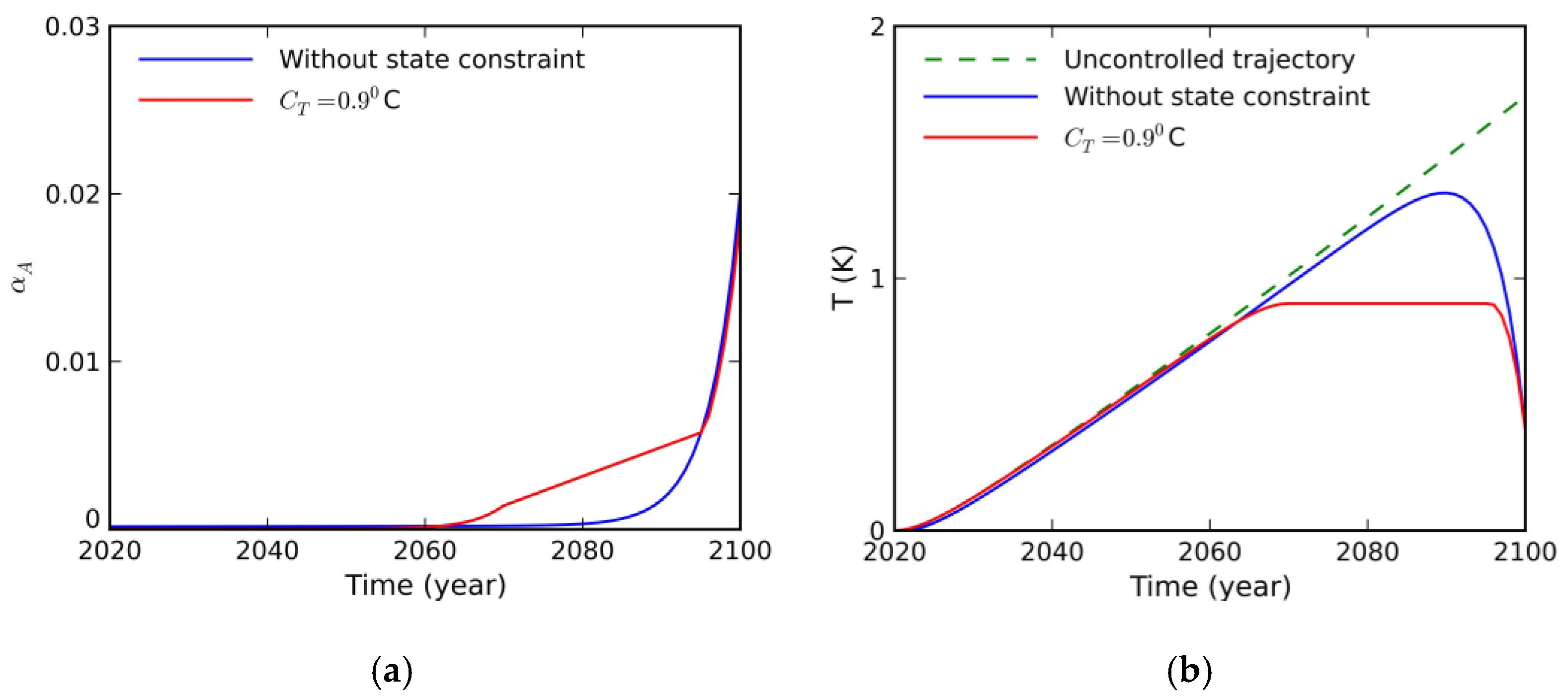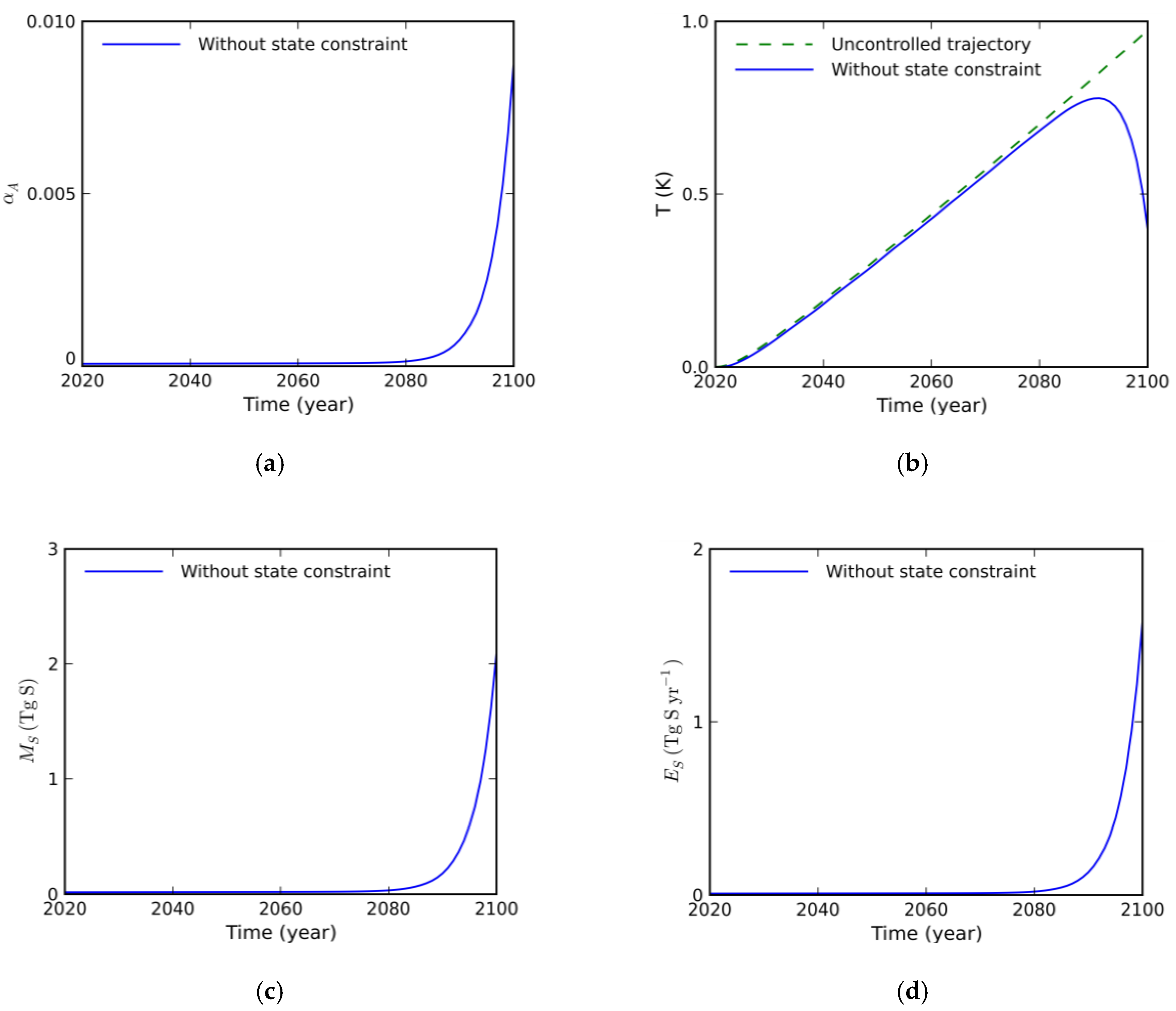Estimating the Impact of Artificially Injected Stratospheric Aerosols on the Global Mean Surface Temperature in the 21th Century
Abstract
1. Introduction
2. Materials and Methods
2.1. The Model of Control Object
2.2. Parameterization of the Aerosols’ Radiative Effect
2.3. Parameterization of the Anthropogenic Radiative Forcing
2.4. Optimal Control Problem Formulation
2.5. Method for Solving the Optimal Control Problem
3. Results and Discussion
- -
- The temperature anomalies and were calculated relative to 2020, i.e., the boundary conditions for and at were and , respectively, where the numerical subscript referred to the year 2020.
- -
- By 2020, would exceed the pre-industrial level by 1.1 °C, i.e., .
- -
- By 2100, would exceed the pre-industrial level by 1.5 °C, i.e., .
- -
- For the 2020 to 2100 period, the rise in should not exceed 2 °C above the pre-industrial level.
4. Concluding Remarks
Funding
Acknowledgments
Conflicts of Interest
References
- Stocker, T.F.; Qin, D.; Planner, G.; Tignor, M.S.; Allen, K.; Boschumg, J.; Alexander, N.; Yu, X.; Vincent, B.; Pauline, M.M. Climate Change 2013: The Physical Science Basis. Contribution of Working Group I to the Fifth Assessment Report of the Intergovernmental Panel on Climate Change; Cambridge University Press: Cambridge, UK, 2013. [Google Scholar]
- Paris Agreement. Available online: https://unfccc.int/sites/default/files/english_paris_agreement.pdf (accessed on 16 August 2018).
- New Climate Institute. Available online: https://unfccc.int/process/the-paris-agreement/long-term-strategies (accessed on 16 August 2018).
- World Meteorological Organization. WMO Statement on the State of the Global Climate in 2017; WMO-No. 1212; World Meteorological Organization: Geneva, Switzerland, 2018. [Google Scholar]
- Rodelj, J.; den Elzen, M.; Höhne, N.; Fransen, T.; Fekete, H.; Winkler, H.; Schaeffer, R.; Sha, F.; Riahi, K.; Meinshausen, M. Paris Agreement climate proposals need a boost to keep warming well below 2 °C. Nature 2016, 534, 631–639. [Google Scholar] [CrossRef]
- Brown, P.; Caldeira, K. Greater future global warming inferred from Earth’s recent energy budget. Nature 2017, 552, 45–50. [Google Scholar] [CrossRef] [PubMed]
- Raftery, A.E.; Zimmer, A.; Frierson, D.M.W.; Startz, R.; Liu, P. Less than 2 °C warming by 2100 unlikely. Nat. Clim. Chang. 2017, 7, 637–641. [Google Scholar] [CrossRef] [PubMed]
- Kong, Y.; Wang, C.-H. Responses and changes in the permafrost and snow water equivalent in the Northern Hemisphere under a scenario of 1.5 °C warming. Adv. Clim. Chang. Res. 2017, 8, 235–244. [Google Scholar] [CrossRef]
- Jacob, D.; Kotova, L.; Teichmann, C.; Stefan, P.S.; Vautard, R.; Chantal, D.; Aristeidis, G.; KoutroulisManolis, G.; GrillakisIoannis, K.T.; Andrea, D. Climate impacts in Europe under +1.5 °C global warming. Earth Future 2018, 6, 264–285. [Google Scholar] [CrossRef]
- Tanaka, K.; O’Neill, B.C. The Paris Agreement zero-emissions goal is not always consistent with the 1.5 °C and 2 °C temperature targets. Nat. Clim. Chang. 2018, 8, 319–324. [Google Scholar] [CrossRef]
- Keith, D.; Mac-Martin, D. A temporary, moderate and responsive scenario for solar geoengineering. Nat. Clim. Chang. 2015, 5, 201–206. [Google Scholar] [CrossRef]
- Chen, Y.; Xin, Y. Implications of geoengineering under the 1.5 °C target: Analysis and policy suggestions. Adv. Clim. Chang. Res. 2017, 8, 123–129. [Google Scholar] [CrossRef]
- MacMartin, D.G.; Ricke, K.L.; Keith, D.W. Solar geoengineering as part of an overall strategy for meeting the 1.5 °C Paris target. Phil. Trans. R. Soc. 2018, 376. [Google Scholar] [CrossRef] [PubMed]
- Henley, B.; King, A. Trajectories toward the 1.5 °C Paris target: Modulation by the Interdecadal Pacific Oscillation. Geophys. Res. Lett. 2017, 44, 4256–4262. [Google Scholar] [CrossRef]
- Budyko, M.I. Climate and Life; Academic Press: New York, USA, 1974. [Google Scholar]
- Crutzen, P.J. Albedo enhancement by stratospheric sulfur injections: A contribution to resolve a policy dilemma? Clim. Chang. 2006, 77, 211–220. [Google Scholar] [CrossRef]
- Bellamy, R.; Chilvers, J.; Vaughan, N.E.; Lenton, T.M. A review of climate geoengineering appraisals. WIREs Clim. Chang. 2012, 3, 597–615. [Google Scholar] [CrossRef]
- Shepherd, J.G. Geoengineering the climate: An overview and update. Philos. Trans. R. Soc. A 2012, 370, 4166–4175. [Google Scholar] [CrossRef] [PubMed]
- Zhang, Z.; Moore, J.C.; Huisingh, D.; Zhao, Y. Review of geoengineering approaches to mitigating climate change. J. Clean. Prod. 2015, 103, 898–907. [Google Scholar] [CrossRef]
- Irvine, P.J.; Kravitz, B.; Lawrence, M.G.; Muri, H. An overview of the Earth system science of solar geoengineering. WIREs Clim. Chang. 2016, 7, 815–833. [Google Scholar] [CrossRef]
- Irvine, P.J.; Kravitz, B.; Lawrence, M.G.; Gerten, D.; Caminade, C.; Gosling, S.N.; Hendy, E.J.; Kassie, B.T.; Kissling, W.D.; Muri, H.; et al. Towards a comprehensive climate impact assessment of solar engineering. Earth Future 2017, 5, 93–106. [Google Scholar] [CrossRef]
- Visioni, D.; Pitari, G.; Aquila, V. Sulfate geoengineering: A review of the factors controlling the needed injection of sulfur dioxide. Atmos. Chem. Phys. 2017, 17, 3879–3889. [Google Scholar] [CrossRef]
- Caldeira, K.; Bala, G. Reflecting on 50 years of geoengineering research. Earth Future 2017, 5, 1–17. [Google Scholar] [CrossRef]
- Boettcher, M.; Schäfer, S. Reflecting upon 10 years of geoengineering research. Earth Future 2017, 5, 266–277. [Google Scholar] [CrossRef]
- Keith, D.W. Geoengineering the Climate: History and Prospect. Annu. Rev. Energy Environ. 2000, 25, 245–284. [Google Scholar] [CrossRef]
- Robock, A.; Marquardt, A.; Kravitz, B.; Stenchikov, G. Benefits, risks, and costs of stratospheric geoengineering. Geophys. Res. Lett. 2009, 36, L19703. [Google Scholar] [CrossRef]
- Robock, A.; Kravitz, B.; Boucher, O. Standardizing experiments in geoengineering. Eos Trans. Am. Geophys. Union 2011, 92, 197. [Google Scholar] [CrossRef]
- Schmidt, H.; Alterskjær, K.; Karam, B.D.; Boucher, O.; Jones, A.; Kristjánsson, J.E.; Niemeier, U.; Schulz, M.; Aaheim, A.; Benduhn, F.; et al. Solar irradiance reduction to counteract radiative forcing from a quadrupling CO2: Climate responses simulated by four earth system models. Earth Syst. Dyn. 2012, 3, 63–78. [Google Scholar] [CrossRef]
- Kravitz, B.; Robock, A.; Boucher, O.; Schmidt, H.; Taylor, K.E.; Stenchikov, G.; Schulz, M. The Geoengineering Model Intercomparison Project (GeoMIP). Atmos. Sci. Lett. 2011, 12, 162–167. [Google Scholar] [CrossRef]
- Kravitz, B.; Robock, A.; Haywood, J.M. Progress in climate model simulations of geoengineering. Eos Trans. Am. Geophys. Union 2012, 93, 340. [Google Scholar] [CrossRef]
- Kravitz, B.; Caldeira, K.; Boucher, O.; Robock, A.; Rasch, P.J.; Alterskjær, K.; Karam, D.B.; Cole, J.N.S.; Curry, C.L.; Haywood, J.M.; et al. Climate model response from the Geoengineering Model Intercomparison Project (GeoMIP). J. Geophys. Res. 2013, 118, 8320–8332. [Google Scholar] [CrossRef]
- Kravitz, B.; Robock, A.; Irvine, P. Robust results from climate model simulations of geoengineering. Eos Trans. Am. Geophys. Union 2013, 94, 292. [Google Scholar] [CrossRef]
- Kravitz, B.; Robock, A.; Tilmes, S.; Boucher, O.; English, J.M.; Irvine, P.J.; Jones, A.; Lawrence, M.G.; MacCracken, M.; Muri, H.; et al. The Geoengineering Model Intercomparison Project Phase 6 (GeoMIP6): Simulation design and preliminary results. Geosci. Model Dev. 2015, 8, 2279–2292. [Google Scholar] [CrossRef]
- MacMartin, D.G.; Keith, D.W.; Kravitz, B.; Caldeira, K. Management of trade-offs in geoengineering through optimal choice of non-uniform radiative forcing. Nat. Clim. Chang. 2013, 3, 365–368. [Google Scholar] [CrossRef]
- Kalidindi, S.; Bala, G.; Modak, A.; Caldeira, K. Modeling of solar radiation management: A comparison of simulations using reduced solar constant and stratospheric sulfate aerosols. Clim. Dyn. 2015, 44, 2909–2925. [Google Scholar] [CrossRef]
- Crook, J.A.; Jackson, L.S.; Osprey, S.M.; Forster, P.M. A comparison of temperature and precipitation responses to different Earth radiation management schemes. J. Geophys. Res. 2015, 120, 9352–9373. [Google Scholar] [CrossRef]
- Qian, Y.; Jackson, C.; Giorgi, F.; Booth, B.; Duan, Q.; Forest, C.; Higdon, D.; Hou, Z.J.; Huerta, G. Uncertainty quantification in climate modelling and prediction. Bull. Am. Meteorol. Soc. 2016, 97, 821–824. [Google Scholar] [CrossRef]
- MacMartin, D.G.; Kravitz, B.; Keith, D.W.; Jarvis, A. Dynamics of the coupled human-climate system resulting from closed-loop control of solar geoengineering. Clim. Dyn. 2014, 43, 243–258. [Google Scholar] [CrossRef]
- Jarvis, A.J.; Young, P.C.; Leedal, D.T.; Chotai, A. A robust sequential CO2 emissions strategy based on optimal control of atmospheric CO2 concentrations. Clim. Chang. 2008, 86, 357–373. [Google Scholar] [CrossRef]
- Jarvis, A.J.; Leedal, D.T.; Taylor, C.J.; Young, P.C. Stabilizing global mean surface temperature: A feedback control perspective. Environ. Model. Softw. 2009, 24, 665–674. [Google Scholar] [CrossRef]
- Ban-Weiss, G.A.; Caldeira, K. Geoengineering as an optimization problem. Environ. Res. Lett. 2010, 5, 034009. [Google Scholar] [CrossRef]
- Jarvis, A.; Leedal, D. The geoengineering model intercomparison project (GeoMIP): A control perspective. Atmos. Sci. Lett. 2012, 13, 157–163. [Google Scholar] [CrossRef]
- Kravitz, B.; MacMartin, D.G.; Leedal, D.T.; Rasch, P.J.; Jarvis, A.J. Explicit feedback and the management of uncertainty in meeting climate objectives with solar geoengineering. Environ. Res. Lett. 2014, 9, 044006. [Google Scholar] [CrossRef]
- Dykema, J.A.; Keith, D.W.; Anderson, J.G.; Weisenstein, D. Stratospheric controlled perturbation experiment: A small-scale experiment to improve understanding of the risks of solar geoengineering. Philos. Trans. A Math. Phys. Eng. Sci. 2014, 372. [Google Scholar] [CrossRef] [PubMed]
- Weller, S.R.; Schultz, B.P. Geoengineering via solar radiation management as a feedback control problem: Controller design for disturbance rejection. In Proceedings of the 4th Australian Control Conference (AUCC), Canberra, Australia, 17–18 November 2014. [Google Scholar]
- Bellman, R. Dynamical Programming; Princeton University Press: Princeton, NJ, USA, 1957. [Google Scholar]
- Pontryagin, L.S.; Bolryanskii, V.G.; Gamktelidze, R.V.; Mishchenko, E.F. The Mathematical Theory of Optimal Processes; Wiley: New York, NY, USA, 1962. [Google Scholar]
- Kirk, D. Optimal Control Theory: An Introduction; Prentice Hall: Englewood Cliffs, NJ, USA, 1970. [Google Scholar]
- Sontag, E.D. Mathematical Control Theory: Deterministic Finite Dimensional Systems; Springer: New York, NY, USA, 1990. [Google Scholar]
- Yusupov, R.M. An Introduction to Geophysical Cybernetics and Environmental Monitoring; St. Petersburg State University Press: St. Petersburg, Russia, 1998. [Google Scholar]
- Soldatenko, S.A. Weather and climate manipulation as an optimal control for adaptive dynamical systems. Complexity 2017, 1–12. [Google Scholar] [CrossRef]
- Meinshausen, M.; Smith, S.J.; Calvin, K.; Daniel, J.S.; Kainuma, M.L.T.; Lamarque, J.-F.; Matsumoto, K.; Montzka, S.A.; Raper, S.C.B.; Riahi, K.; et al. The RCP greenhouse gas concentrations and their extensions from 1765 to 2300. Clim. Chang. 2011, 109, 213–241. [Google Scholar] [CrossRef]
- Gregory, J.M.; Mitchell, J.F.B. The climate response to CO2 of the Hadley Centre coupled AOGCM with and without flux adjustment. Geophys. Res. Lett. 1997, 24, 1943–1946. [Google Scholar] [CrossRef]
- Gregory, J.M. Vertical heat transports in the ocean and their effect on time-dependent climate change. Clim. Dyn. 2000, 16, 501–515. [Google Scholar] [CrossRef]
- Held, I.M.; Winton, M.; Takahashi, K.; Delworth, T.; Zeng, F.; Vallis, G.K. Probing the fast and slow components of global warming by returning abruptly to preindustrial forcing. J. Clim. 2010, 23, 2418–2427. [Google Scholar] [CrossRef]
- Geoffroy, O.; Saint-Martin, D.; Olivié, D.J.L.; Voldoire, A.; Bellon, G.; Tytéca, S. Transient climate response in a two-layer energy-balance model. Part I: Analytical solution and parameter calibration using CMIP5 AOGCM experiments. J. Clim. 2012, 26, 1841–1857. [Google Scholar] [CrossRef]
- Geoffroy, O.; Saint-Martin, D.; Bellon, G.; Voldoire, A.; Olivié, D.J.L.; Tytéca, S. Transient climate response in a two-layer energy-balance model. Part II: Representation of the efficacy of deep-ocean heat uptake and validation for CMIP5 AOGCMs. J. Clim. 2013, 26, 1859–1876. [Google Scholar] [CrossRef]
- Gregory, J.M.; Andrews, T.; Good, P. The inconstancy of the transient climate response parameter under increasing CO2. Philos. Trans. R. Soc. A 2015, 373, 20140417. [Google Scholar] [CrossRef] [PubMed]
- Gregory, J.M.; Andrews, T. Variation in climate sensitivity and feedback parameters during the historical period. Geophys. Res. Lett. 2016, 43, 3911–3920. [Google Scholar] [CrossRef]
- Farmer, G.T.; Cook, J. Earth’s Albedo, Radiative Forcing and Climate Change. In Climate Change Science: A Modern Synthesis; Springer: Dordrecht, The Netherlands, 2018; pp. 217–229. [Google Scholar]
- Pistone, K.; Eisenman, I.; Ramanathan, V. Observational determination of albedo decrease caused by vanishing Arctic sea ice. Proc. Natl. Acad. Sci. USA 2014, 111, 3322–3326. [Google Scholar] [CrossRef] [PubMed]
- Calabrò, E.; Magazù, S. Correlation between Increases of the Annual Global Solar Radiation and the Ground Albedo Solar Radiation due to Desertification—A Possible Factor Contributing to Climatic Change. Climate 2016, 4, 64. [Google Scholar] [CrossRef]
- Rutherford, W.A.; Painter, T.H.; Ferrenberg, S.; Belnap, J.; Okin, G.S.; Flagg, C.; Reed, S.C. Albedo feedbacks to future climate via climate change impacts on dryland biocrusts. Sci. Rep. 2017, 7, 44188. [Google Scholar] [CrossRef] [PubMed]
- Kreidenweis, U.; Humpenöder, F.; Stevanović, M.; Bodirsky, B.L.; Kriegler, E.; Lotze-Campen, H.; Popp, A. Afforestation to mitigate climate change: Impacts on food prices under consideration of albedo effects. Environ. Res. Lett. 2016, 11, 085001. [Google Scholar] [CrossRef]
- Fassnacht, S.R.; Cherry, M.L.; Venable, N.B.H.; Saavedra, F. Snow and albedo climate change impacts across the United States Northern Great Plains. Cryosphere 2016, 10, 329–339. [Google Scholar] [CrossRef]
- Cohen, S.; Stanhill, G. Widespread Surface Solar Radiation Changes and Their Effects: Dimming and Brightening. In Climate Change. Observed Impacts on Planet Earth, 2nd ed.; Letcher, T.M., Ed.; Elsevier: Amsterdam, The Netherlands, 2016; pp. 491–511. [Google Scholar]
- Kravitz, B.; Rasch, P.J.; Wang, H.; Robock, A.; Gabriel, C.; Boucher, O.; Cole, J.N.S.; Haywood, J.; Ji, D.; Jones, A.; et al. The climate effects of increasing ocean albedo: An idealized representation of solar geoengineering. Atmos. Chem. Phys. 2018, 18, 13097–13113. [Google Scholar] [CrossRef]
- Bluth, G.J.S.; Doiron, S.D.; Schnetzler, C.C.; Krueger, A.J.; Walter, L.S. Global tracking of the SO2 clouds from the June, 1991 Mount-Pinatubo eruptions. Geophys. Res. Lett. 1992, 19, 151–154. [Google Scholar] [CrossRef]
- Eliseev, A.V.; Chernokulsky, A.V.; Karpenko, A.A.; Mokhov, I.I. Global warming mitigation by sulfur loading in the stratosphere: Dependence of required emissions on allowable residual warming rate. Theor. Appl. Climatol. 2010, 101, 67–81. [Google Scholar] [CrossRef]
- Hansen, J.; Sato, M.; Ruedy, R.; Nazarenko, L.; Lacis, A.; Sato, R.; Ruedy, L.; Nazarenko, A.; Lacis, G.A.; Schmidt, G.; et al. Efficacy of climate forcing. J. Geophys. Res. 2005, 110, D18104. [Google Scholar] [CrossRef]
- Lenton, T.M.; Vaughan, N.E. The radiative forcing potential of different climate geoengineering options. Atmos. Chem. Phys. 2009, 9, 5539–5561. [Google Scholar] [CrossRef]
- McGuffie, K.; Henderson-Sellers, A. A Climate Modelling Primer, 3rd ed.; Wiley: New York, NY, USA, 2005. [Google Scholar]
- Karper, H.; Engler, H. Mathematics and Climate; SIAM: Philadelphia, PA, USA, 2013. [Google Scholar]
- Rasch, P.J.; Tilmes, S.; Turco, R.; Robock, A.; Oman, L.; Chen, C.-C.; Stenchikov, G.L.; Garcia, R.R. An overview of geoengineering of climate using stratospheric sulphate aerosols. Philos. Trans. R. Soc. A 2008, 366, 4007–4037. [Google Scholar] [CrossRef] [PubMed]
- Myhre, G.; Highwood, E.J.; Shine, K.P.; Stordal, F. New estimates of radiative forcing due to well mixed greenhouse gases. Geophys. Res. Lett. 1998, 25, 2715–2718. [Google Scholar] [CrossRef]
- Myhre, G.D.; Shindell, F.-M.; Bréon, W.; Collins, J.; Fuglestvedt, J.; Huang, D.; Koch, J.-F.; Lamarque, D.; Lee, B.; Mendoza, T.; et al. Anthropogenic and Natural Radiative Forcing Supplementary Material. In Climate Change 2013: The Physical Science Basis. Contribution of Working Group I to the Fifth Assessment Report of the Intergovernmental Panel on Climate Change; Stocker, T.F., Qin, D., Plattner, G.-K., Tignor, M., Allen, S.K., Boschung, J., Nauels, A., Xia, Y., Bex, V., Midgley, P.M., Eds.; World Meteorological Organization: Geneva, Switzerland, 2013. [Google Scholar]
- Bryson, A.E.; Ho, Y.-C. Appled Optimal Control: Optimization, Estimation, and Control; Wiley: New York, NY, USA, 1975. [Google Scholar]
- Sethi, S.P.; Thompson, G.L. Optimal Control Theory: Application to Management Science and Economics; Springer: New York, NY, USA, 2000. [Google Scholar]
- Intergovernmental Panel on Climate Change (IPCC). Summary for Policymakers. In Climate Change 2014: Mitigation of Climate Change. Contribution of Working Group III to the Fifth Assessment Report of the Intergovernmental Panel on Climate Change; Edenhofer, O.R., Pichs-Madruga, Y., Sokona, E., Farahani, S., Kadner, K., Seyboth, A., Adler, I., Baum, S., Brunner, P., Eickemeier, B., et al., Eds.; Cambridge University Press: Cambridge, UK; New York, NY, USA, 2014. [Google Scholar]
- Ricker, K.L.; Millar, R.J.; MacMartin, D.G. Constraints on global temperature target overshoot. Sci. Rep. 2017, 7, 14743. [Google Scholar] [CrossRef] [PubMed]






| Scenario | RCP8.5 | 1pctCO2 | RCP6 | RCP4.5 |
|---|---|---|---|---|
| η (W m−2 yr−1) | 10−2 | 10−2 | 10−2 | 10−2 |
| Scenario | RCP8.5 | 1pctCO2 | RCP6.0 | RCP4.5 |
|---|---|---|---|---|
| T (K) | 3.16 (4.26) | 2.34 (3.44) | 1.70 (2.80) | 0.96 (2.06) |
| Scenario | RCP8.5 | 1pctCO2 | RCP6 | RCP4.5 |
|---|---|---|---|---|
| T (K) | 2.48 | 1.84 | 1.34 | 0.78 |
| Scenario | RCP8.5 | 1pctCO2 | RCP6 | RCP4.5 |
|---|---|---|---|---|
| without state constraint | 36.5 | 25.6 | 17.0 | 7.7 |
| with state constraint | 73.6 | 44.46 | 23.3 | - |
© 2018 by the author. Licensee MDPI, Basel, Switzerland. This article is an open access article distributed under the terms and conditions of the Creative Commons Attribution (CC BY) license (http://creativecommons.org/licenses/by/4.0/).
Share and Cite
Soldatenko, S.A. Estimating the Impact of Artificially Injected Stratospheric Aerosols on the Global Mean Surface Temperature in the 21th Century. Climate 2018, 6, 85. https://doi.org/10.3390/cli6040085
Soldatenko SA. Estimating the Impact of Artificially Injected Stratospheric Aerosols on the Global Mean Surface Temperature in the 21th Century. Climate. 2018; 6(4):85. https://doi.org/10.3390/cli6040085
Chicago/Turabian StyleSoldatenko, Sergei A. 2018. "Estimating the Impact of Artificially Injected Stratospheric Aerosols on the Global Mean Surface Temperature in the 21th Century" Climate 6, no. 4: 85. https://doi.org/10.3390/cli6040085
APA StyleSoldatenko, S. A. (2018). Estimating the Impact of Artificially Injected Stratospheric Aerosols on the Global Mean Surface Temperature in the 21th Century. Climate, 6(4), 85. https://doi.org/10.3390/cli6040085





